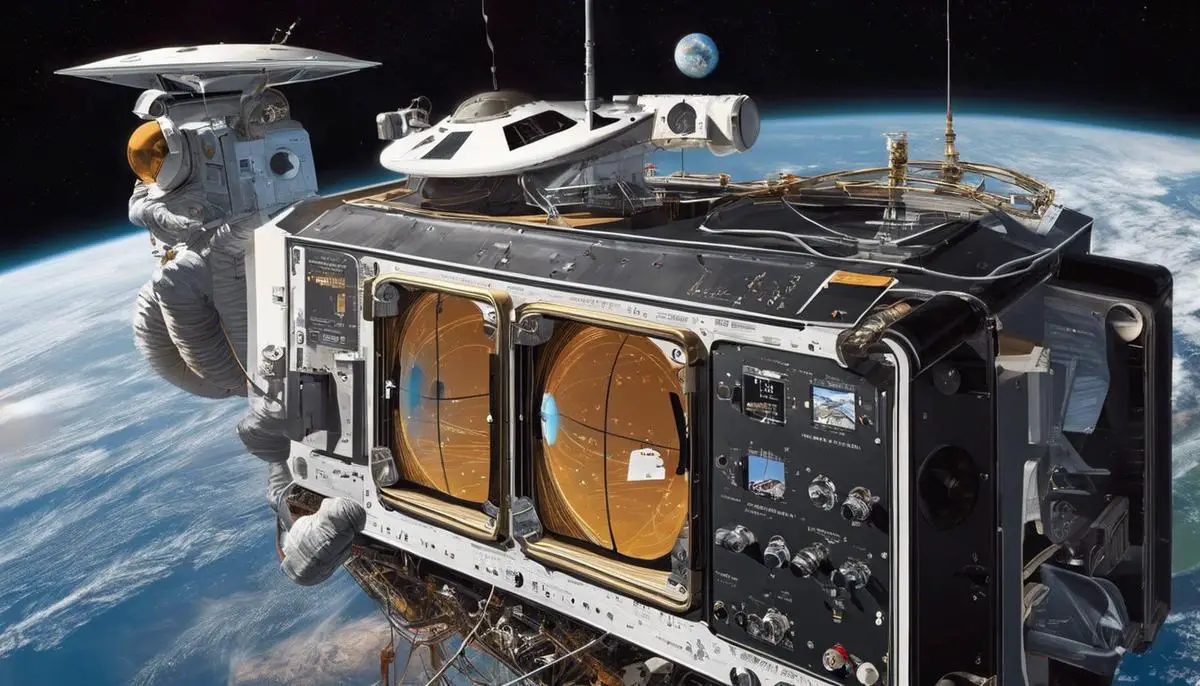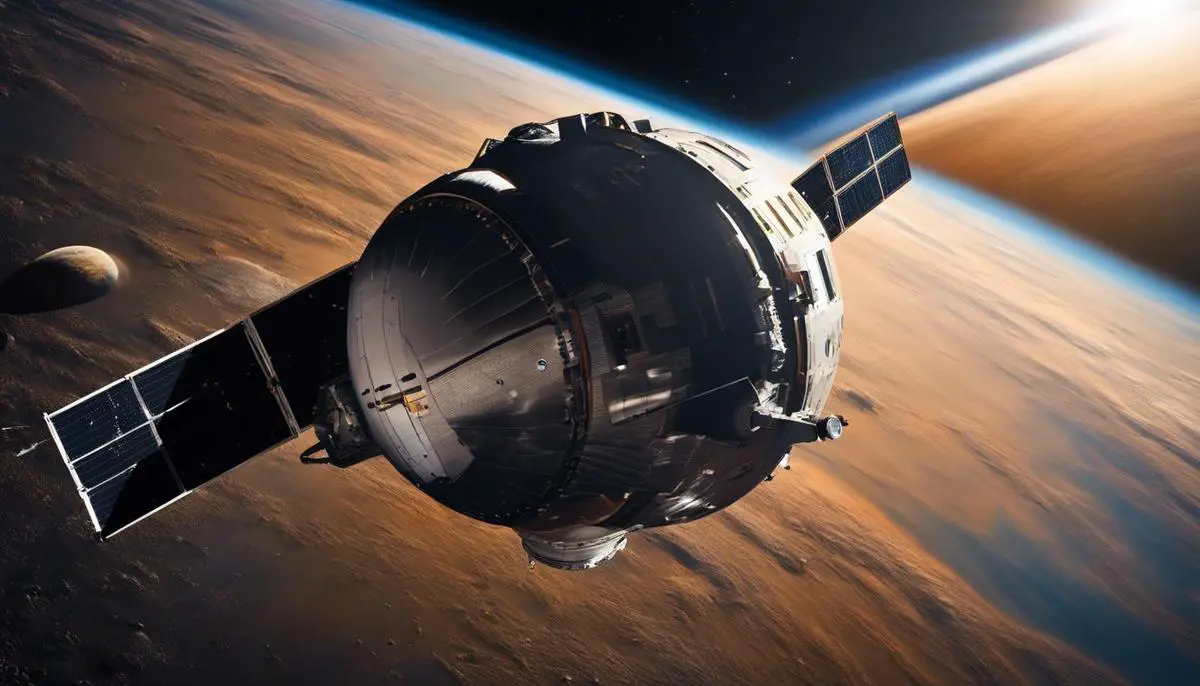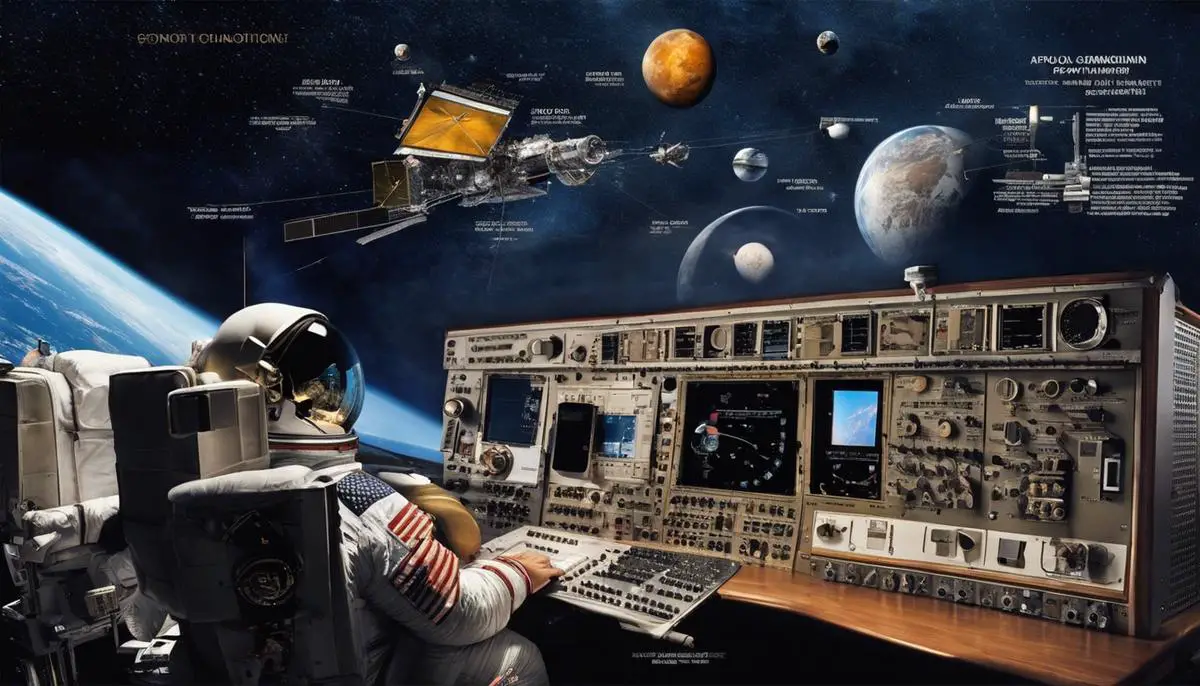Primed in the crucible of Apollo missions, the evolution of communication systems is a testament to man’s relentless pursuit of excellence and passion for discovery. The Apollo series, from Apollo 1 to Apollo 17, each one a stepping stone in technological advancement, bore witness to several challenges and transformations. Throughout this journey, the focus of our narrative paints the evolution, the Unified S-Band system’s devising, functioning of spacecraft data systems, and the far-reaching impact on mass communication. As renowned industry experts, we delve deep into this riveting drama of technological feat dotted with innovation, ambition and audacity.
Contents
Evolution of Communication Systems in Apollo Missions
The Evolution of Communication Systems in the Apollo Missions
The race towards space exploration in the mid-twentieth century was a remarkable testament to human ingenuity and bravado. Unarguably, the defining moments of this era were encapsulated in the Apollo missions spearheaded by NASA, renowned for their groundbreaking strides in technology, one of which was the remarkable evolution of communication systems.
Throughout the Apollo missions, the advancements in communication systems were indispensable, shifting from the rudimentary Saturn I Block II telemetry system to the sophisticated Unified S-Band (USB) system, permitting a seamless transition into a new age of space exploration.
In the embryonic stages of the Apollo Program, the Saturn I Block II telemetry system served as the essential communication linchpin. This system utilized Very High-Frequency (VHF) radio signals to transmit and receive data, affording scientists on the ground with real-time data display and analog-to-digital conversion. However, its limitations were glaring – demands for higher data rates and more substantial data quantity warranted a fresh approach.
The need for this paradigm shift brought life to the Unified S-Band (USB) system. This transformative technology was a single communication system that could handle voice communication, telemetry, and television signals simultaneously. Its agility was further evidenced in its compatibility with both ground stations and the Apollo Lunar Module, signaling a revolution in space communication.
The Unified S-Band (USB) system manifested remarkable advancements. For starters, it eschewed the VHF signals for S-band signals, exhibiting greater resistance to interference and yielding cleaner, more accurate data transmission. Moreover, it dynamically adjusted the transmission power requirements, further optimizing communication efficiency.
The Apollo missions saw the debut of the USB system in Apollo 7. Its flawless operation cemented its place as a staple in subsequent crafts, including the iconic Apollo 11 mission. Astronaut Neil Armstrong’s timeless phrase: “That’s one small step for man, one giant leap for mankind,” was relayed back to Earth through the USB system, signifying its prolific role within the spacecraft.
Subsequent missions witnessed minor enhancements in the USB system, consistent with constraints and requirements, such as the Apollo 13 mission that utilized a Block II Command Module with a modified USB system to compensate for the reduced power due to an onboard explosion.
With these technological innovations, the Apollo Missions unequivocally redefined the limits of human reach and amplified the profound connection between deep space and the blue sphere we call home. Even today, these communication upgrades continue to illuminate the pathways, serving as essential scaffolding in humanity’s relentless quest for interstellar journeys.

Significance of the Unified S-Band System
Bearing in mind the foundational knowledge laid in the preceding discussion on Apollo missions’ communication systems, we can dive deeper into the effects of Unified S-Band (USB) architecture in nurturing the modern advancements in communication.
The USB system, developed by NASA in the mid-1960s, set the blueprint for modern communication systems. By harmonizing voice transmission, telemetry, and radar tracking into one single channel, the USB concept decidedly addressed the roadblocks posed by the earlier Saturn I Block II telemetry system. This innovative philosophy carved out a revolutionary pathway in data transfer and communication technology.
An insightful exploration into the USB’s features and the technical underpinnings will provide a fresh perspective on the extent to which this system has shaped today’s communication paradigms. The principle of frequency multiplexing, underpinning the USB, is now an essential feature of every modern communication infrastructure. It allows for the management of different data types, a technique now ubiquitous in cell towers, satellite networks, and wireless routers.
Furthermore, Quadrature Amplitude Modulation (QAM), employed in the USB system to enhance performance, has established its presence in the technology serving Wi-Fi, television broadcasting, and 4G/5G networks. QAM has been instrumental in expanding data capacity, resulting in wider bandwidths and faster communication speeds.
The USB, with its coherent transponder, engendered a vital development; Doppler tracking, which finds applications in Global Positioning System (GPS) services. By precisely measuring the change in frequency of the returned signal, the USB rendered accurate real-time tracking and navigation viable. This transcended the space frontier and is now pivotal to numerous terrestrial applications, including navigation and weather forecast systems.
Without the robust, resilient, and ultra-reliable USB, the Apollo astronauts may never have made that ‘giant leap for mankind. Today’s digital landscape, packed with high-definition multimedia streaming, wireless internet connections, and satellite navigation, owes a great deal to the pioneering work that crafted Apollo’s USB system.
The Unified S-Band system, thus, was not only a critical asset that upheld the Apollo missions but also acted as a catalyst propelling the global communication sector into an era of hyper-connectivity. Its relevance echoes even today, as scientists continue to learn from its engineering, innovate upon its design, and adapt its principles to meet the demands of the digital world and future cosmos missions. Indeed, Apollo, with its giant leap, has left an enduring imprint on both Earth and Space.
Thus, by penning the final touch to the in-depth study of the Unified S-Band system, it’s vital to note that our voyage into the cosmos, both past and future, is deeply embedded in the triumphs and ingenuity of our communication endeavours. Its influence will resonate in every beep of data that journeys across the cosmos, bearing testimony to a legacy that has transcended the confines of our atmosphere and continues to shape our digital universe.

Spacecraft Data Systems During Apollo Missions
The Apollo missions stand as historical landmarks, underlining human potential in technological advancement and desire for exploration. Beyond the Universal S-Band (USB) system, other integral technological advancements underpinned the success of these pivotal lunar explorations. A key focus will be the Apollo Guidance Computer, for its remarkable contribution cannot be overstated.
It is crucial first to understand the environment in which the Apollo Guidance Computer (AGC) was developed. In the 1960s, computers were mammoth devices, inhabiting entire rooms, and by modern standards, were drastically limited in processing power. NASA’s demand for an efficient, compact computer for the Apollo spacecraft summoned a daunting challenge to the engineers and scientists of that era.
The AGC was an epitome of innovation in its time and paved the way for modern computing. It was among the first to employ integrated circuits, leading to miniaturization and improved reliability. Memory was another area where AGC exceeded expectations, utilizing a unique form of read-only memory (ROM) known as ‘rope memory’. This high-density storage solution allowed a substantial amount of information to be stored within the tight weight and space limitations of the Apollo spacecraft.
One of the unique innovations was the “priority scheduling”, an operating system approach where important tasks were given processing precedence. This innovative multitasking method allowed for crucial calculations to be undertaken even while coping with multiple ongoing tasks. The approach is now a mainstay of modern operating systems.
The interface design of the AGC, called the DSKY, was another commendable achievement. While seemingly primitive by current standards, the simple numeric keypad and basic displays were perfect for environments where astronauts wearing bulky spacesuits would find complex interfaces almost impossible to operate. This mindset of ‘minimalism’ is now a key design principle in modern user interface design.
Stepping beyond the realms of Apollo missions, AGC’s design concepts extended an influential role in modern computing. The integrated circuits used in the AGC fast-tracked electronics miniaturization leading to today’s microprocessor revolution. Its innovative storage system, priority scheduling, and cleverly simplistic user interface design laid the groundwork for the evolution of computing systems and devices we witness today.
In the age of advanced Mars missions and interplanetary satellite exploration, the trace of Apollo missions’ technological advancements finds itself firmly embedded. Innovations birthed by the space expedition requirements continue to guide digital technology, showing the lasting legacy of humanity’s small step, which indeed was a giant leap for mankind’s scientific progression.

Impact of Apollo Missions on Mass Communication
Building on the aforementioned context of the Apollo missions and the Unified S-Band communication system, it is pertinent to delve a bit deeper into one of the iconic gems of the Apollo era – the Apollo Guidance Computer (AGC). This onboard computer was fundamental to NASA’s manned lunar missions, exemplifying remarkable technological evolution in the 1960s.
Engineers and scientists were confronted with colossal challenges in developing the AGC. They were tasked with creating a reliable, lightweight computer capable of real-time computations while enduring the demanding space environment. This shifted the focus onto integrating circuits and miniaturization, effectively pioneering the digital revolution.
Integrated circuits, then a novel technology, served as the basis of AGC’s hardware. At the heart of the AGC was an innovative chip – a block of semiconductor carrying miniature transistors and other electronic components. The integration of thousands of these transistors dramatically reduced the computer’s size and weight while enhancing computational speed and reliability.
To solve the storage conundrum, a unique memory storage solution was introduced, using ‘rope memory.’ This non-volatile memory form, weaved by hand, stored programs and data reliably. A slight nod to history’s loom-based weaving, only in this instance, it was used for encoding software instructions into hardware.
The AGC also implemented a “priority scheduling” approach to its operating system, an ingenious tactic that ensured vital tasks were not bypassed amidst intense lunar landing procedures. This represented the kernel of the multi-tasking abilities prevalent in computers today.
Surprisingly primitive by today’s standards, the AGC interface, known as the DSKY (Display and Keyboard Unit), bridged astronaut interactions with the AGC. However, the user-friendly design of the DSKY, featuring an array of push buttons and numeric displays, prefigured the emergence of personal computers.
The AGC and its technological marvels inevitably left an indelible imprint on modern computing. Despite its departure from active service, its influence did not wane. It can be seen in the upsurge of the microprocessor revolution and the modern computers that we heavily rely on today.
Thus, the enduring legacy of the Apollo missions transcends the realm of space exploration. It ignited a technological revolution – from reshaping mass communication systems to pioneering the digital revolution. The echoes of Apollo’s footsteps on lunar soil can still be heard, resonating within modern digital technology, with its relevance ever-more pertinent in propelling future cosmic explorations.

The Apollo missions, emblematic of an era of furious experimentation and unapologetic ambition, revolutionized the world of communication and technology, laying an irreversible impact on societal aspects such as television broadcasting, radio telecommunication and digital media. A quest that began with Apollo 1 and spanned to Apollo 17 etched a narrative of human audacity and resolve. In this pursuit of the stars, technologies were born, evolved, and were perfected, rationalizing modern-day dynamics of global communication systems, and setting the stage for the future. As we analyze and interpret this journey, we realize that the roots of our present lie embedded in these past endeavors – underscoring the pertinence of understanding and appreciating our technological heritage.
